Understanding the German side of the fighting in Normandy
The battle for the Cotentin peninsula began on D-Day and witnessed some of the most intense fighting of the Normandy campaign, with heavy losses on both sides. This six week battle of attrition set the stage for the decisive American breakout from the Bocage. Dutch historian Niels Henkemans is therefore going to write a series of books on this topic. Two books have already come out: Defending Normandy 1A and 1B. TracesOfWar asked him some questions by e-mail about this books and his future writing projects.
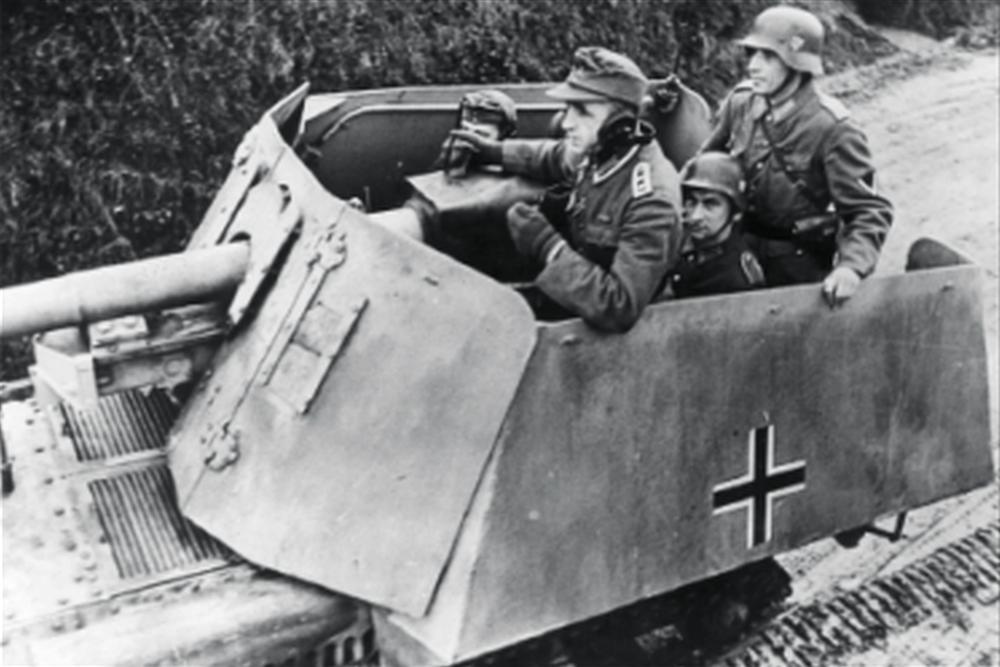 The Marder I was a small size tankhunter, but for the occasion five men have managed to cram themselves into the fighting compartment. Source: Archives du Calvados
The Marder I was a small size tankhunter, but for the occasion five men have managed to cram themselves into the fighting compartment. Source: Archives du CalvadosSince when have you been interested in the battle for the Cotentin peninsula and why? What exactly is the historical significance of this battle?
I’ve always been interested in history and as a teenager I started to focus more and more on the battle for Normandy. I really enjoyed building scale models (tanks, AFV’s, etc.) and tried to get them as historically accurate as possible. At some point I came across French tanks that were captured in 1940 and still used by the Germans in Normandy in 1944. I found that really interesting and started to collect more information to build some accurate models. I learned that two battalions had such tanks on the Cotentin Peninsula so that was what first really drew my attention to that sector.
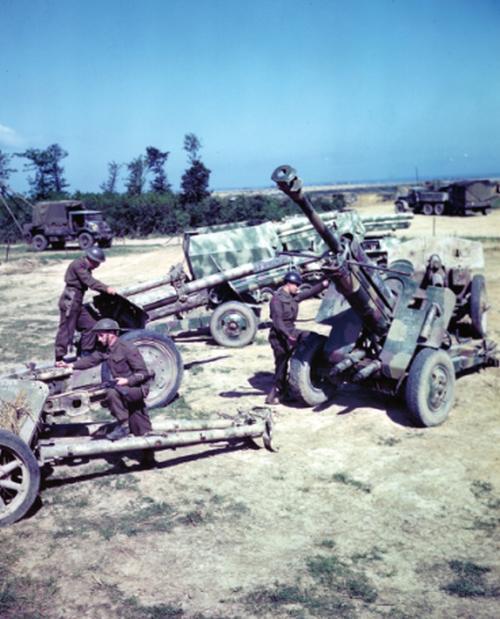 The German forces in Normandy used a wide variety of artillery. This photo shows several types of guns also used by the 265. Infanterie-Division.
The German forces in Normandy used a wide variety of artillery. This photo shows several types of guns also used by the 265. Infanterie-Division.In 2006 I wrote my first online article (they’re still on the missing-lynx forums) about German armour on the Cotentin. People were really enthusiastic and started sending me more information. They also suggested I’d write a book about the subject. At first I rejected the idea, but I was getting so much information I started to organise the material and that started to grow into a book. So I figured ‘why not give this a chance’. At this time the idea was to write a campaign book about US and German armour on the peninsula. But when I started to actually write it I realised that a lot of the information in publications was either incorrect or just missing. This was especially true for the German side of the story. I was convinced I could only write a campaign book if I first took a deeper look at the German forces. That is what led to the Defending Normandy book series. It’s a side-project that got out of hand.
You’ve already published two volumes of the series. What topics are these books about?
The first book (Vol. 1A) tries to do two things. It starts with explaining the German Chain of Command before and after the invasion. It has a lot of attention for the history of the 84th Army Corps (LXXXIV. A.K.) which arrived in Normandy in the spring of 1941 and was still responsible for its defence on D-Day. By understanding the history of the Corps it is easier to understand what happened in Normandy before the invasion. That, in turn, explains much of what happened after D-Day. The book also covers the organisation of the Corps headquarters and some smaller units directly under its command. The second part of the book and Vol. 1B look at infantry divisions in general and six in particular that fought on the peninsula.
How would you describe the format of your books? Are you trying to distinguish your work from that of other writers?
My books are quite unique as they do not follow the usual campaign style narrative, but focusses on each formation individually. This may sound strange, but each formation presents a piece of the puzzle if you want to understand Normandy as a whole. Doing a single narrative cannot capture that in the same level of detail. When you combine the stories of each formation you’ll get the most complete picture possible, but you’ll have to study them individually. I approach each formation in three steps: organisation & equipment, pre-D-Day history, and post-D-Day history. This is a very meticulous way to understand what a formation actually was, how it developed and what I did during the battle for Normandy.
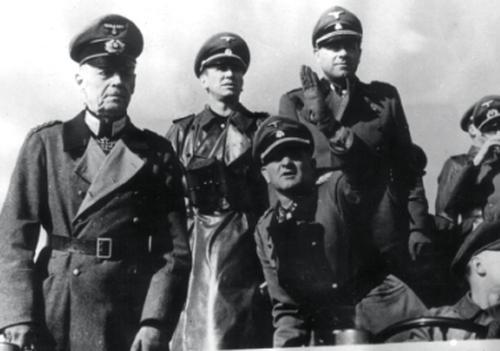 The I. SS-Panzerkorps played a key part in the fighting in the eastern half of the beachhead. Here we see its commander, SS-Oberst-Gruppenführer Josef ‘Sepp’ Dietrich, informing Generalfeldmarschall Gerd von Rundstedt during a visit before the invasion. Source: The National Archives of Canada
The I. SS-Panzerkorps played a key part in the fighting in the eastern half of the beachhead. Here we see its commander, SS-Oberst-Gruppenführer Josef ‘Sepp’ Dietrich, informing Generalfeldmarschall Gerd von Rundstedt during a visit before the invasion. Source: The National Archives of CanadaAre there any historians or writers who inspire you, and what is your favourite book by another author about the Battle of Normandy?
I took most of my inspiration from Niklas Zetterling’s work. A lot of people love his ‘Normandy 1944’ book because of the dozens and dozens of micro unit histories. When I started doing my own research it helped me get started with finding records. As I expanded my research more and more it also became clear that there was still a lot more information available and that it would be possible to write much more about all of those formations to better understand them.
How do you research the topics you write about? Are you using previously unknown sources?
My research is almost entirely based on original records. That includes (captured) German records, Allied records, allied intelligence, KIA records, PW interrogations, etc., etc. Hundreds of thousands of pages. A lot of these source haven’t been used in the past, or only minor bits of them. I try to combine everything relevant to reconstruct these formations and support everything with endnotes so other researchers or enthusiasts can find the information as well.
Do your books have a specific target audience and what do you hope readers remember after reading your work?
My books do not have a specific target audience but I would say they are aimed at people who want to go a bit deeper and want to really understand the German side of the fighting in Normandy. In that sense the books are aimed more at history buffs and wargamers than at model builders. The books are text heavy but also have dozens of full colour maps (almost all directly based on original German maps) and lots of Order of Battle charts. Photos are fewer in number. Yes, I’d love to include more photos but I try to use German photos from the actual area. Those are, unfortunately, very rare.
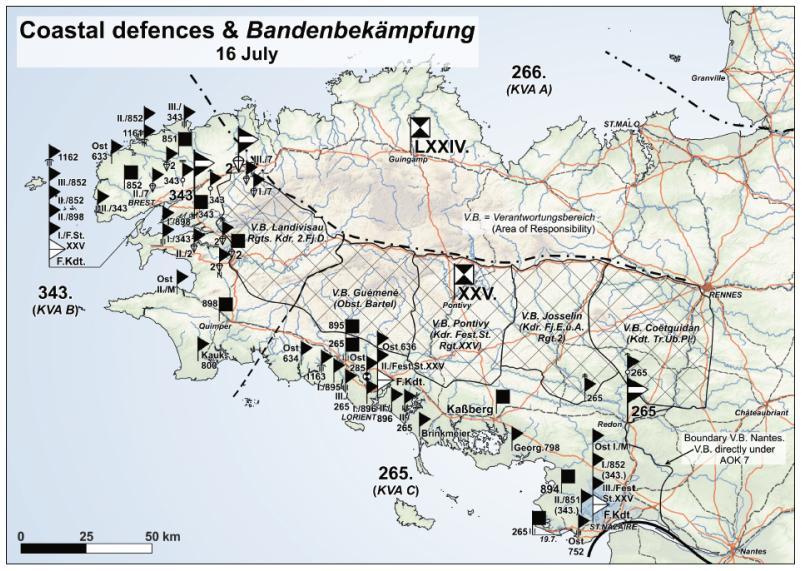 In Bretagne the Germans faces growing difficulties in defending the coast with decreasing numbers of troops, and an increase in resistance activity island. Map made by Niels Henkemans
In Bretagne the Germans faces growing difficulties in defending the coast with decreasing numbers of troops, and an increase in resistance activity island. Map made by Niels HenkemansI would be very pleased if people come away from my books with a more balanced and fact based view of German troops in Normandy. These formations and their complexity are truly fascinating and even the smallest formation can be unique and surprising. Also, a lot of what we think we know and what is written in countless publications is not based on original research or now terribly outdated. When people talk about German forces I hear a lot of myths or clichés. Even from experts. My books try to tell a story based on new and original research based on actual records and bring that to the English speaking world. If the books help a new generation of historians and enthusiast get a better understanding of German forces I’d be very, very happy.
How many volumes should the series consist of and have you already started working on the next volume? If so, what is it about?
I get this question a lot and I do not really have an answer. For formations on the Cotentin I think I’ll end up with five books. Those will include Panzer formation, antitank units, artillery formations, engineers, Flak, Fallschirmjäger and SS troops. So a lot of ground to cover. Vol. 2 will focus on independent infantry formations and the Osttruppen (eastern volunteers). A lot of those fought on the peninsula and I will include their story with a general introduction of those formations. They are really fascinating, but also difficult to understand. And that’s true for pretty much all German formations.
Click on the cover image to order the book on Amazon.com: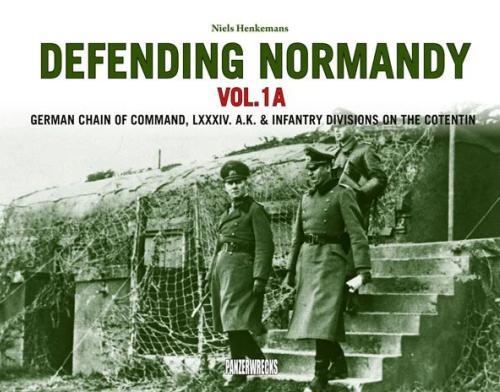
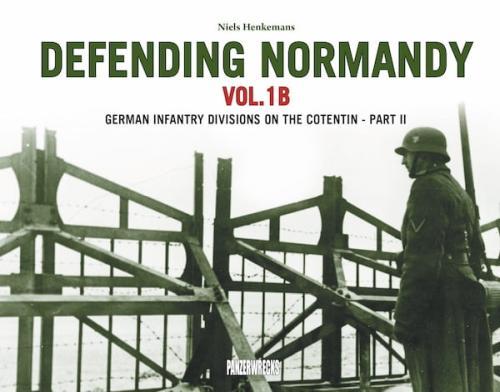
Used source(s)
- Source: Niels Henkemans / TracesOfWar
- Published on: 12-04-2025 18:28:00
Related news
- 11-'24: Postal artifacts provide a vibrant testament to the experiences of the Dutch people during WWII
- 10-'24: DigitalBattlefieldTours unlocks military tactics to a wide audience
- 08-'24: Researching his father’s WWII history became a passion for Steve Snyder
- 08-'24: Who was the owner of the photo album from Dachau?
- 07-'24: The British people welcomed African American servicemen with open arms
Latest news
- 03-03: A WWII helmet returns home 80 years after having been lost at Remagen Bridge, Germany
- 16-02: Armin T. Wegner and his letter to Hitler
- 14-02: The hugely popular ‘Standing with Giants’ installation returns to the British Normandy Memorial
- 27-01: Russia focuses on Soviet victims of WW2 as officials not invited to Auschwitz ceremony
- 27-01: Oswald Kaduk, ‘Papa Kaduk’ or a monster??
- 12-'24: Christmas and New Year message from our volunteers
- 11-'24: New book: Righteous Behind Barbed Wire
- 11-'24: Postal artifacts provide a vibrant testament to the experiences of the Dutch people during WWII
- 10-'24: DigitalBattlefieldTours unlocks military tactics to a wide audience
- 10-'24: Lily Ebert, Holocaust Survivor, Author and TikTok Star, Dies at 100


